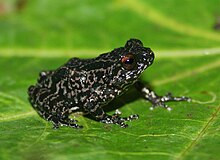Raorchestes ghatei
Ghate's shrub frog (Roarchestes ghatei) is a frog. It lives in India. Scientists have seen it in the Western Ghat mountains 600 to 1000 meters above sea level, in places with evergreen trees.[2][3][1]
| Raorchestes ghatei | |
|---|---|

| |
| Scientific classification | |
| Domain: | Eukaryota |
| Kingdom: | Animalia |
| Phylum: | Chordata |
| Class: | Amphibia |
| Order: | Anura |
| Family: | Rhacophoridae |
| Genus: | Raorchestes |
| Species: | R. ghatei
|
| Binomial name | |
| Raorchestes ghatei Padhye, Sayyed, Jadhav, and Dahanukar, 2013
| |
This frog lives in forests with at least some evergreen trees and in places with smaller woody plants. It can live in forests that have never been cut down and in forests that have been cut down and are growing again.[1]
The adult male frog is about 9.1-25.5 mm long from nose to rear end and the adult female frog is about 15.4-29.8 mm long. The adult male frog and adult female frog are different colors. The skin of the adult female frog's back is dark in color with light patterns and black stripes from the eardrum to where the legs meet the body. There are black stripes on the front and back legs. The middle of the body is cream-white in color and yellow-orange nearer to the legs. The skin of the adult male frog's back is dark brown in color with black stripes from the eardrum to where the legs meet the body. The front legs are dark in color with no stripes. The back legs have spots. The middle of the body is cream-white in color. The adult male frog has a tubercule spike on his arm bone.[3][4]
The adult male frog chooses a place near the ground to sit on and then sings for the female frogs. Sometimes male frogs fight over good perches. After a strong male frog wins a fight, the other male frogs either leave or do not sing. Scientists have seen R. ghatei try to mate with other frogs, such as Microhyla ornata or Uperodon mormorata.[3]
The female frog lays 40-60 eggs at a time. She lays them under a rock or in dead leaves on the ground. If she lays the eggs before monsoon season, she will leave them alone. But if she lays the eggs after monsoon season, she will stay nearby to guard them. The eggs will hatch if it is not too hot and not too cold: 20-22 °C. The eggs take 21-30 days to hatch. The eggs hatch into small frogs. These frogs are never tadpoles.[3]
Adult frogs eat insects and other animals without bones. Young frogs eat mosquitoes and other insects. Snakes like the bamboo pitviper and saw-scaled viper, lizards like the forest lizard and changeable lizard, and birds like the white-throated kingfisher will all eat this frog.
Scientists believe this frog is not in danger of dying out because it lives in such a large place. But human beings change the places where the frog lives.[1] Humans cut down trees to get wood to build things and to make room for farms. Scientists also saw that a fungus that causes the disease chytridiomycosis can make this frog sick.[3]
References
change- ↑ 1.0 1.1 1.2 1.3 IUCN SSC Amphibian Specialist Group (2023). "Ghate's Shrub Frog: Raorchestes ghatei". IUCN Red List of Threatened Species. 2023: e.T79128538A166116668. doi:10.2305/IUCN.UK.2023-1.RLTS.T79128538A166116668.en. Retrieved March 9, 2024.
- ↑ Frost, Darrel R. "Raorchestes ghatei Padhye, Sayyed, Jadhav, and Dahanukar, 2013". Amphibian Species of the World, an Online Reference. Version 6.0. American Museum of Natural History, New York. Retrieved September 17, 2023.
- ↑ 3.0 3.1 3.2 3.3 3.4 Breeze Davis; Kathryn Thai; Mireya Bejarano (June 1, 2021). Ann T. Chang; Michelle S. Koo (eds.). "Raorchestes ghatei Padhye, Sayyed, Jadhav, and Dahanukar, 2013". AmphibiaWeb. University of California, Berkeley. Retrieved September 17, 2023.
- ↑ Padhye AD; Sayyed A; Jadhav A; Dahanukar N (2013). "Raorchestes ghatei, a new species of shrub frog (Anura: Rhacophoridae) from the western Ghars of Maharashtra, India". J Threatened Taxa (Abstract). 5 (15): 4913–4931. Retrieved September 17, 2023.
